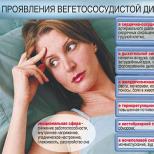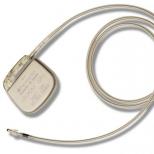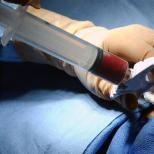Is vegetovascular dystonia dangerous?
“All diseases are from the nerves,” a wise man once said. Vegetative vascular dystonia (VVD) is one of the most common, yet little studied problems. whose implications cannot be underestimated. VSD is not considered a disease. It is not in ICD 10. According to the official point of view, VVD is one of the symptoms of completely different pathologies.. According to statistics, 30% of the world's population, or even more, suffers from the consequences of VVD. It occurs in both adults and children. VSD is more common in women than in men. Each person, at any time, can notice its manifestations, and feel the consequences of the VVD on themselves.
Violation of the autonomic nervous system
All organs and organ systems that make up the human body have their own duties and mission. The autonomic nervous system is responsible for regulating the tone of blood vessels. Of course, this is not its only function, there are many, many more. It is responsible for maintaining homeostasis. Provides speed of response to different circumstances. The instinct of self-preservation relies on her work. In part, it provides a behavioral stereotype. Disorders of its functions - VVD is a dangerous condition, the consequences of which should not be underestimated.. They may be the most serious.
With VVD, the function of regulating the tone of blood vessels suffers primarily., smooth muscle innervation. The consequences of this state can be changes in the degree of nutrition of tissues of different organs, the intensity of the elimination of toxins - metabolic processes. The consequences of these changes are hypotension and hypertension. The natural motility of some internal organs is disturbed - the intestines, larynx, valves, bronchi, and this is not all the consequences of this disease.
The consequences of VVD are manifested in periodic attacks, the so-called hypertensive crises.. The consequences of hypertensive crises can be very sad. They are last 10 minutes for one person, and for another an hour or more. The frequency and duration depends on individual characteristics, anamnesis, clinical picture.
Over time, the clinical picture may become more complicated, complications appear. What are the consequences of VVD? In many cases, we are talking about a reduction in life expectancy. We are always talking about the deterioration of its quality.
Symptoms in a crisis

What exactly happens during a crisis and what are its consequences? VVD is a complex of disorders, the consequences of which can be various changes in the functioning of the body.
Changes:
- heart rate;
- arterial pressure;
- normal rhythm of insulin synthesis;
- adrenaline.
The consequences of the VVD crisis will be the feeling of a person, as if he finds himself in another reality, in which the body is not his at all. The heart beats more and more, irregularly in some cases, breathing is lost, weakness is felt, it hurts and the head is spinning. Thoughts during an IRR crisis can be confused, or they can remain extremely clear. The body begins to freeze, sometimes a person begins to sweat intensely, the temperature rises. Paleness of the face or, conversely, redness is a sign of an VSD crisis. Pre-fainting state. Are VVD crises life-threatening? If the attack began in a public place, it is very frightening. It is dangerous to drive a car, cross roads with heavy traffic - the consequences are not predictable.
The consequences of VVD crises often become panic attacks, neurosis. These consequences of VVD cause no less problems than the disorder itself. They have to be treated together. The clinical picture may be different, the disorder will develop according to a different scenario.
The most dangerous consequences of VVD
What prognosis can the doctor make if he notices that the patient has signs of VVD? What will be the consequences if you do not treat the VVD, do not go to the doctor at all? A reaction to the lead, preventive measures can save you from such dangerous consequences of the disease as:
- heart attack;
- stroke;
- development of hypertension.
A timely visit to the hospital, therapy will improve the situation with VVD and prevent the unpleasant consequences of the disease.
Causes and background

Most often, VVD develops against the background of:
- oxygen supply disorders in an unborn child (intrauterine hypoxia);
- birth trauma;
- endocrine diseases;
- pathologies of the gastrointestinal tract;
- infectious diseases.
It is customary to distinguish the following types of VSD:
- respiratory;
- cardiac;
- sexual;
- dyspeptic;
- thermoregulatory;
- psychoneurological.
Respiratory

The autonomic nervous system regulates smooth muscle contraction. The bronchi are one of her areas of responsibility. The consequences of respiratory VVD can be violations of the innervation of these muscles and manifest themselves in the inability to take a deep breath. You have to breathe often.
Breathing exercises help to normalize innervation by willpower, imply artificial breath holding in a certain sequence. Inhalations and exhalations should not be sharp. If they are sharp, there is a risk of spasm. Rhythm is the main principle. Gymnastics should not cause negative emotions, sensations. It is necessary to start with the minimum delay in inhalation, exhalation, gradually increase the time. In this way, you can cope with the unpleasant consequences of respiratory VVD.
Cardiac

The consequences of this type of VVD can be recognized by the right sign - there are pains in the heart, among other symptoms. It can be felt in the form of tingling, be sharp, aching, expressed as a dull pain, heaviness, burning. It can spread from the heart to the area between the shoulder blades, under the left shoulder blade, to the neck, face. It's hard to bear it.
It appears due to problems with blood pressure. Sometimes occurs as a reaction to the weather. The consequences of this condition - a cardiac vegetative vascular crisis may develop as a reaction to physical overwork, after drinking alcoholic beverages or spicy food.
The crisis in cardiac VSD can often be stopped only with medication.. The doctor prescribes nitroglycerin or aspirin, which must be taken during an attack to prevent its consequences. Also, during a crisis, you need to sit down, limit activity, normalize breathing. Open windows in the room to let in fresh air.
Sexy
In some cases, this type of VVD is closely related to the sexual sphere, sexuality. The consequences of crises of the sexual type of VVD are the appearance of pain in the groin area in both men and women - during intimacy, before or after it. Anorgasmia is a complication that can occur in men. In this case, the person is sexually aroused but unable to experience orgasm. Women sometimes develop infertility. All these are the consequences of sexual VVD.
Both men and women may develop phobic reactions. It happens that intimate meetings cause excitement. This affects the level of adrenaline in the blood, the frequency of contraction of the heart muscle, and blood pressure. A hypertensive crisis develops with different symptoms. Another of the dangerous consequences of VVD.
Sometimes there is a close relationship between meetings and attacks, a behavioral reaction is formed. The body, the psyche is trying in this way to gain control over the autonomic nervous system, to restore homeostasis. It is important not to aggravate the psychological state, to treat VVD, and not to withdraw into oneself, part with a partner, file for divorce, so as not to aggravate the consequences of the disease.
Dyspeptic
This type of VVD is characterized by localization of symptoms in the gastrointestinal tract. Its consequences are manifested in the fact that diarrhea can develop or vice versa constipation. Belching, heaviness or pain in the stomach, flatulence - all these are dyspeptic symptoms. They tire, exhaust, exhaust. The disorder is associated with impaired innervation. It's not about food, although sometimes you can find that a crisis develops after taking certain foods, drinks, foods. All these are the consequences of dyspeptic VVD.
Stress is the most common cause of this type of disorder. But to find out whether this is so, whether it is the whole point, is possible only after a comprehensive examination, when all the tests prescribed by the doctor will be passed. It is dangerous to ignore the symptoms. The consequences can be expressed in serious disorders in the body, because the metabolism, all tissues and cells, tissues of the digestive tract suffer. The consequences of VSD can be serious. Like oxygen starvation, a lack of vitamins, a violation of the water balance is a dangerous condition.
Thermoregulatory
The consequences of thermoregulatory VVD are expressed in endocrine disorders, malfunctions of the immune system cause violations of thermoregulation. Thermoregulatory VSD is accompanied by a temperature of +38, for example, or chills, a decrease in temperature. What are the possible consequences of such symptoms? They adversely affect the entire body. As a result, panic attacks often develop - during a walk, on the street. Consequences - the weather, the environment begins to frighten.
The consequences of this type of vegetative vascular dystonia can also be a heat stroke if the VSD crisis begins in the summer, in the park and is accompanied by an increase in temperature. Frostbite can be a consequence of a crisis with a decrease in body temperature in winter. Restoring natural thermoregulation is a long process. It is important to remember that a person long ago began to change it by an effort of will, began to sew clothes. Due to this, the habitat has expanded, but what the norm is is difficult to say. Hardening, contrast shower strengthens thermoregulation. It can be used as one of the methods of therapy to minimize the consequences.
Neuropsychiatric
Changes in mental processes are sometimes observed with VVD. Consequences of the disease - attention suffers, the degree of its concentration decreases. The emotional background changes - aggression, irritability, anxiety appear. Also, the consequences include the possible development of depression as a complication, due to lack of sunlight, malnutrition and general emotional instability. Increased fatigue, sleep disturbance worries even when the state of health is generally normal - these are the consequences of the neuropsychiatric type of VVD. The VSD crises themselves manifest themselves in the form of panic attacks, neuroses.
The consequences of VVD, causes, symptoms are dangerous to ignore. Although it is difficult to understand what is wrong, intraceptive perception does not give such an opportunity, there is no reason to be afraid. Exteroceptive perception is related to interoceptive. Theoretically, if one process is disrupted, the other will also be disrupted. Some forms of VVD are dangerous in that they resemble hallucinations at first. But they have quite understandable reasons - these are the consequences of violations of the function of regulating the tone of blood vessels, the innervation of smooth muscles.





